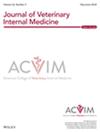Spinal arachnoid diverticula in cats: Clinical presentation, diagnostic imaging findings, treatment, and outcome
Abstract
Background
Spinal arachnoid diverticulum (SAD) is considered a rare disease in cats. Previous reports mainly classified SAD in cats as acquired.
Hypothesis/Objectives
The aim of this study was to describe the signalment, clinical presentation, diagnostic imaging findings, and outcome in a group of cats with SAD.
Animals
Twenty-one client-owned cats.
Methods
Multicenter observational retrospective review of the medical records of cats diagnosed with SAD by magnetic resonance imaging.
Results
Most cats were Domestic Short Hair (67%), male (63%), and had a wide range of ages (18 weeks to 13 years old). Neuroanatomical localization was consistent with a T3-L3 myelopathy in 18 cats (86%) and C1-C5 myelopathy in 3 cats (14%). One cat with a C1-C5 myelopathy demonstrated bilateral vestibular clinical signs. One cat (5%) had fecal incontinence. Most cats demonstrated a chronic, progressive, nonlateralized, nonpainful myelopathy. No underlying previous or concurrent spinal condition was found in 48% of the cats. No difference in age, body weight, breed, sex, treatment, or outcome was found between cats with or without a concurrent spinal disorder. One cat was euthanized after diagnosis. Six cats improved, 1 deteriorated and 1 remained static after surgery, whereas 3 cats improved, 5 deteriorated and 4 remained static after medical management on the short-term outcome. Overall, 73% (8/11) of the cats deteriorated on available long-term follow-up information.
Conclusions and Clinical Importance
Spinal arachnoid diverticulum should be considered for cats with chronic, progressive, symmetrical, nonpainful myelopathy, particularly if male and with a history of spinal disease or surgery.


 求助内容:
求助内容: 应助结果提醒方式:
应助结果提醒方式:


